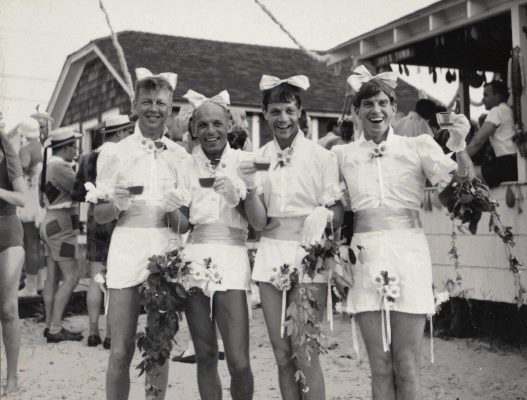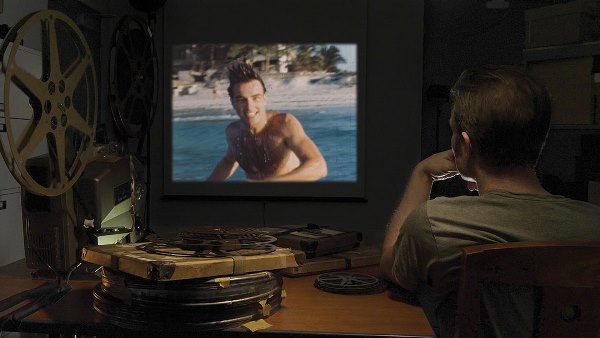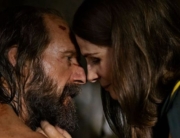This year’s NewFest, New York City’s annual celebration of cinema reflecting the perspectives of the LGBTQ community, is now in full swing. Among the festival selections are four documentaries, each of which revolves around an untold, forgotten, or overlooked story getting its chance to be told.
In Cherry Grove Stories, an intergenerational cross section of mostly gay men looks back fondly on the titular Fire Island resort town, which has long been referred to as the Gay Shangri-La. They offer an insider’s perspective of a place where, for many of them, they felt able to be themselves without fear of harassment for the first time in their lives. Director Michael Fisher’s subjects range from longtime residents, who initially glimpsed Cherry Grove back when it was a spartan beachfront enclave during the late 1940s, to those who bought houses after it had evolved into a thriving, queer-friendly destination.
Some of the more colorful stories center on hedonism: the wild parties and the spots on the island where sexual activities were known to occur right in public view. These tales are cheeky to be sure, but when juxtaposed with conditions in New York City prior to the Stonewall riots, they point to just how transgressive Cherry Grove was for its time.
But what also becomes clear is that this paradise was hardly been perfect. One interviewee describes anti-Semitic attitudes, while others take fellow residents to task for staying largely uninvolved with the gay rights movement of the 1970s, so as not to jeopardize their own comfort and security. The police did eventually start to crack down on homosexual activity in Cherry Grove, as evident by various subjects’ pulse-pounding descriptions of narrow escapes. These are some of the more affecting sections of the film, along with anecdotes about good-hearted straight neighbors and an especially poignant segment in which interviewees mourn for community members they lost during the AIDS epidemic.
Among the wide sampling of voices are later generations of gay men and lesbians disagreeing with their elders regarding Cherry Grove’s legacy. Another way Fisher juxtaposes the past and present is by occasionally utilizing a split screen, thereby pointing out how certain aspects of the town have changed, while others endure. That leads into a larger conversation about how much more acceptable being gay is nowadays, and how necessary Cherry Grove remains to those who aren’t comfortable being themselves everywhere just yet.
Cherry Grove Stories screens on Saturday, October 27 and Tuesday, October 30.
Largely shot between 2007 and 2017 with a Sony Handycam, I Hate New York takes viewers into a bygone era of the city’s nightclubs. Employing a loose narrative structure, the film revolves around transgender performers, who were constantly pushing the boundaries of their craft. Model and performer Amanda Lepore, fellow multi-hyphenate Sophia Lamar, and musicians T De Long and Chloe Dzubilo discuss their approaches to their work, as well as their love-hate feelings toward New York City.
Director Gustavo Sánchez cuts back-and-forth between his subjects as they navigate a scene that frequently comes across as raw and seedy, but also edgy and exciting. Meanwhile, his approach highlights the scene’s diverse artistry: Lepore, for example, utilized her cosmetically enhanced body as her main commodity, while Lamar’s aesthetic involved flamboyant costumes. As for Long and Dzubilo, they approached music through very different lenses—one as a trans man and the other as a trans woman—as well as different genres.
Each protagonist has their share of advocates who chime in about their rightful place in New York City’s nightlife hierarchy, but the lasting impression we get of their universe is how combustible it was. Those who were once allies start up a feud between themselves, joint success not being enough for them. Meanwhile, the most poignant story line involves two who find romance and stability but whose happiness burns out quickly as a result of the same demons that has made their art so memorable.
For his part, Sánchez’s love for this scene and its inhabitants is clear not just through the sheer number of years he spent taping his subjects but how he curated the footage. He goes to great lengths to reveal them not just as performers; they’re three-dimensional human beings with backstories, private lives, and, at least for a time, futures ahead of them.
Making Montgomery Clift attempts to debunk much of the myth surrounding the legendary actor, such as the assumption that the personal demons surrounding his homosexuality led him to self-destruct. The filmmakers—one of whom is Clift’s real-life nephew—make a persuasive argument that, quite to the contrary, he was very much at peace with his own sexuality. What really drove the oft-enigmatic star, the film argues, was a need for creative independence above all, which his post-mortem biographers found too difficult to wrap their heads around, and so they settled for armchair psychoanalysis and regurgitating the same salacious rumors about him.
The evidence includes interviews with a select few who knew Clift when he was alive and audio recordings and home movies collected by Brooks Clift, the actor’s brother and co-director Robert Clift’s father. Through them, we see a very different side to the film’s subject, who was reputed to be largely haunted. However, he appears here in private moments to be happy and carefree. Robert and co-helmer Hillary Demmon also present archived evidence that Montgomery was not nearly as indecisive and insecure as the accepted lore made him out to be. On the contrary, his notorious pickiness over movie roles reflected a highly calculating nature.
But while the impetus of the film is unearthing the real Montgomery Clift, the narrative gradually shifts into something different but no less compelling: Robert’s attempt to reclaim his family’s legacy. Along with challenging the perception of Montgomery’s supposedly broken mental and emotional state, the film revisits the figure of Brooks, whom the press had framed as an eccentric for his penchant to record nearly every phone call. The filmmakers strongly imply this tendency was no quirk but possibly the result of psychological damage from what Brooks witnessed during World War II. In addition, Brooks’s audio recordings of his attempts to get acclaimed biographer Patricia Bosworth to correct mistakes in her 1978 book about Montgomery—and her seeming indifference to do so—paint him in a decidedly more tragic light.
Despite how much of Making Montgomery Clift consists of talking heads and unearthed audio recordings, it does not feel especially static, and much credit for that goes to its unique editing style, which merges still photography with samples from Brooks’s collection of audio recordings. By cutting back-and-forth between different photographs of the protagonists, there is the illusion of movement and an actual conversation that we see as well as hear. Along with bringing the older generations of the Clift family back to life, the film restores their dignity, which is its most impressive accomplishment.
Making Montgomery Clift screens on Tuesday, October 30.
The subjects of Tristan Aitchison’s powerful Sidney & Friends tell their stories directly to the camera, resulting in an intimate record of abuses endured by Kenya’s intersex and trans community. The film starts out profiling Sidney Etemisi and his close friend Ben, who were pressured to dress and behave as women, but they self-identified as men from a very young age. As they got older, they were verbally harassed, received death threats, and were physically assaulted by family members and local religious leaders, who believed demons were in possession of their bodies.
Looking at the subjects in the present day through Aitchison’s stark black-and-white cinematography, the toll stemming from years of emotional, psychological, and bodily trauma is very much evident. Unfortunately, their current circumstances are not much better, due to laws that allow employers to easily discriminate against those who are intersex or transgender, which resulted in Sidney and Ben living in one of Nairobi’s slums. We glimpse the dilapidated urban landscape via photographs taken by the director.
The film contains a stray ray of hope now and then, mostly in scenes in which the protagonists are together with their clique, telling stories, laughing, and showing each other affection. Besides Sidney and Ben, two others prove especially compelling: Guillit, an activist for trans- and intersex-related issues, is a mostly strong, soulful presence, although even he occasionally wonders if there is hope for any of them in Kenya. Maria, a vivacious trans woman, aspires to be a fashion model, and she is seemingly comfortable with herself as she is—at one point dismissing the idea of gender reassignment surgery.
Some of the most interesting scenes in Sidney & Friends involve the protagonists describing the difficulty of existing in a society that does not yet recognize them as their own category and instead lumps them together with its gay population. Aitchison shot the film over the course of three years. Unfortunately by the end, Kenya seems no closer to taking that next leap. Nevertheless, this is a film with considerable empathy for its subjects, recognizing that they are driven by the basic needs: love, stability, acknowledgement. That keeps it from becoming mainly a series of bleak portraits and leads to a conclusion that is genuinely moving.
Sidney & Friends screens on Saturday, October 27.








Leave A Comment